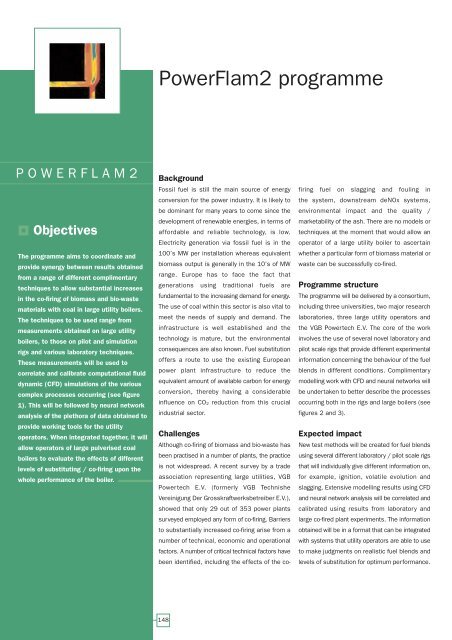European Bio-Energy Projects
European Bio-Energy Projects
European Bio-Energy Projects
Create successful ePaper yourself
Turn your PDF publications into a flip-book with our unique Google optimized e-Paper software.
POWERFLAM2<br />
Objectives<br />
The programme aims to coordinate and<br />
provide synergy between results obtained<br />
from a range of different complimentary<br />
techniques to allow substantial increases<br />
in the co-firing of biomass and bio-waste<br />
materials with coal in large utility boilers.<br />
The techniques to be used range from<br />
measurements obtained on large utility<br />
boilers, to those on pilot and simulation<br />
rigs and various laboratory techniques.<br />
These measurements will be used to<br />
correlate and calibrate computational fluid<br />
dynamic (CFD) simulations of the various<br />
complex processes occurring (see figure<br />
1). This will be followed by neural network<br />
analysis of the plethora of data obtained to<br />
provide working tools for the utility<br />
operators. When integrated together, it will<br />
allow operators of large pulverised coal<br />
boilers to evaluate the effects of different<br />
levels of substituting / co-firing upon the<br />
whole performance of the boiler.<br />
PowerFlam2 programme<br />
Background<br />
Fossil fuel is still the main source of energy<br />
conversion for the power industry. It is likely to<br />
be dominant for many years to come since the<br />
development of renewable energies, in terms of<br />
affordable and reliable technology, is low.<br />
Electricity generation via fossil fuel is in the<br />
100’s MW per installation whereas equivalent<br />
biomass output is generally in the 10’s of MW<br />
range. Europe has to face the fact that<br />
generations using traditional fuels are<br />
fundamental to the increasing demand for energy.<br />
The use of coal within this sector is also vital to<br />
meet the needs of supply and demand. The<br />
infrastructure is well established and the<br />
technology is mature, but the environmental<br />
consequences are also known. Fuel substitution<br />
offers a route to use the existing <strong>European</strong><br />
power plant infrastructure to reduce the<br />
equivalent amount of available carbon for energy<br />
conversion, thereby having a considerable<br />
influence on CO2 reduction from this crucial<br />
industrial sector.<br />
Challenges<br />
Although co-firing of biomass and bio-waste has<br />
been practised in a number of plants, the practice<br />
is not widespread. A recent survey by a trade<br />
association representing large utilities, VGB<br />
Powertech E.V. (formerly VGB Technishe<br />
Vereinigung Der Grosskraftwerksbetreiber E.V.),<br />
showed that only 29 out of 353 power plants<br />
surveyed employed any form of co-firing. Barriers<br />
to substantially increased co-firing arise from a<br />
number of technical, economic and operational<br />
factors. A number of critical technical factors have<br />
been identified, including the effects of the co-<br />
148<br />
firing fuel on slagging and fouling in<br />
the system, downstream deNOx systems,<br />
environmental impact and the quality /<br />
marketability of the ash. There are no models or<br />
techniques at the moment that would allow an<br />
operator of a large utility boiler to ascertain<br />
whether a particular form of biomass material or<br />
waste can be successfully co-fired.<br />
Programme structure<br />
The programme will be delivered by a consortium,<br />
including three universities, two major research<br />
laboratories, three large utility operators and<br />
the VGB Powertech E.V. The core of the work<br />
involves the use of several novel laboratory and<br />
pilot scale rigs that provide different experimental<br />
information concerning the behaviour of the fuel<br />
blends in different conditions. Complimentary<br />
modelling work with CFD and neural networks will<br />
be undertaken to better describe the processes<br />
occurring both in the rigs and large boilers (see<br />
figures 2 and 3).<br />
Expected impact<br />
New test methods will be created for fuel blends<br />
using several different laboratory / pilot scale rigs<br />
that will individually give different information on,<br />
for example, ignition, volatile evolution and<br />
slagging. Extensive modelling results using CFD<br />
and neural network analysis will be correlated and<br />
calibrated using results from laboratory and<br />
large co-fired plant experiments. The information<br />
obtained will be in a format that can be integrated<br />
with systems that utility operators are able to use<br />
to make judgments on realistic fuel blends and<br />
levels of substitution for optimum performance.

















